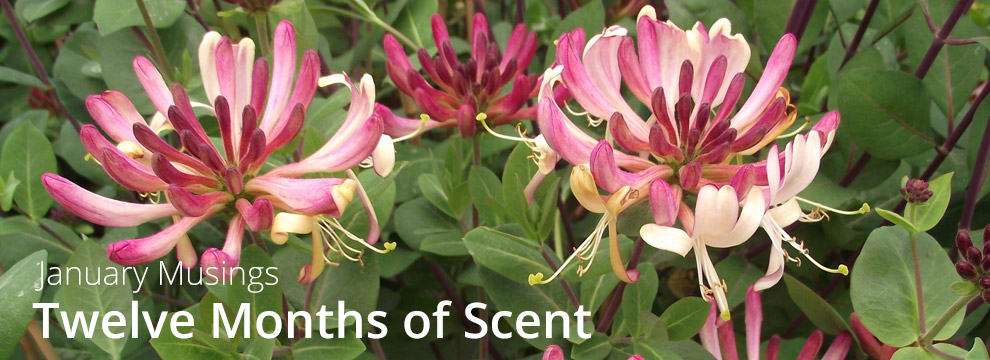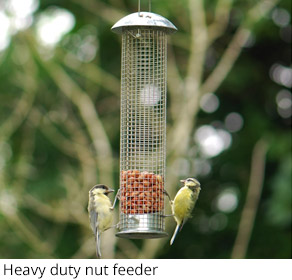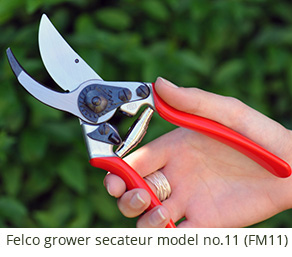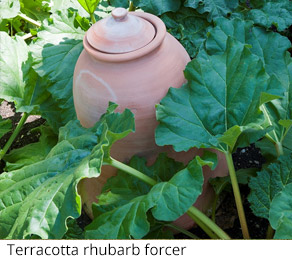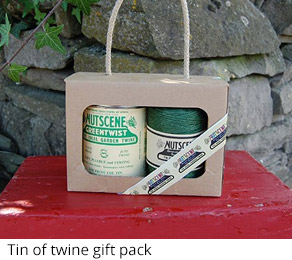Gardening's not all about hard work and dirty fingers thankfully. It’s sensuous and hedonistic and it fills the soul with pleasure and satisfaction. Sometimes the pleasure’s all visual and at this time of year it might be a snowdrop thrusting through the soil, or a lumbering queen bumblebee dusted in pollen. It can stop you in your tracks as you admire unexpected beauty. However scent’s the real deal. It creeps over you and evokes some distant memory or other in a nanosecond. Before you know it, you’re looking back in time, softened by a fragrance that seems to seep into the very soul. So every gardener should aspire to planting fragrant flowers and it’s quite possible to have a series throughout the year. Find a quiet spot where it’s warm and bright, so that the nectar flows, and you’ll be surprised how far fragrance can travel and how pleasing it can be!
Winter Gems
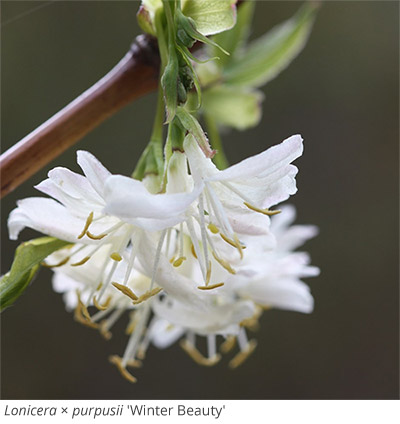 Winter flowering shrubs can be surprisingly fragrant because winter flowers are usually small and rather inconspicuous so that they avoid being ravaged by wintry extremes. Pollinators are lured in by scent instead and at this time of year a lot of solitary bees and bumblebees are on the wing. They emerge from hibernation in desperate need of a nectar fix, for energy and protein-rich pollen for breeding. Honey bees can also fly on mild afternoons, so you’ll be sustaining wildlife as well as having your own aromatherapy experience. Winter flowering shrubs can be surprisingly fragrant because winter flowers are usually small and rather inconspicuous so that they avoid being ravaged by wintry extremes. Pollinators are lured in by scent instead and at this time of year a lot of solitary bees and bumblebees are on the wing. They emerge from hibernation in desperate need of a nectar fix, for energy and protein-rich pollen for breeding. Honey bees can also fly on mild afternoons, so you’ll be sustaining wildlife as well as having your own aromatherapy experience.
The winter-flowering honeysuckle, Lonicera x purpusii ‘Winter Beauty’ is often out close to the New Year or earlier. It’s a non-climbing shrubby honeysuckle with pendant ivory-white flowers and these attract any bees brave enough to venture out on a sunny afternoon. It’s very sweetly fragrant and the aroma carries well so it’s worth placing this medium-sized, wide shrub close to a path or gateway. The twiggy branches also pick well and the buds will open indoors. You can trim back some of the branches of winter honeysuckle after flowering, should you wish.
By January the days are getting longer once again and this is when Daphne bholua 'Jacqueline Postill’ begins to open its roundels of waxy-pink flowers set against shiny green foliage. This columnar shrub needs a warm, sheltered site because harsh winters can cut it back, although it always revives from the base so do be patient. The heady scent, reminiscent of lilies, is especially noticeable on warmer winter afternoons. The flowers persist until late March, at least, so this is a delight for several weeks. ‘Jacqueline Postill', raised at Hilliers by their propagator Alan Postill, will put on a foot a year if happy and finally reach 4m. A mature specimen can be covered with hundreds of flowers, although in cold winters this daphne may drop its leaves.

By February you can feel the sun on your back and, if you have room, a wintersweet (Chimonanthus praecox) is delightful addition. The translucent, pallid-yellow flowers pack a fragrant punch and they have a hint of tomato-red that warms the flowers to the eye. Although wintersweet has a reputation for being less than hardy, it does survive in an open position but a cold winter can ruin the flowers. However it does have the strongest scent of any shrub on a cold day. It picks well for the vase, outlasting other winter-flowering shrubs in water. If space is shorter opt for a Sarcococca also known as Christmas box and sweet box. These highly fragrant small evergreen shrubs can be accommodated in a pot and just a few flowers will scent the air close to front door. Sarcococca hookeriana var. digyna is the most highly scented of all, with pinkish flowers, although the ivory-white flowers and deep green foliage of S. confusa go particularly well in pots with Christmas roses (Helleborus niger).
Spring into Summer
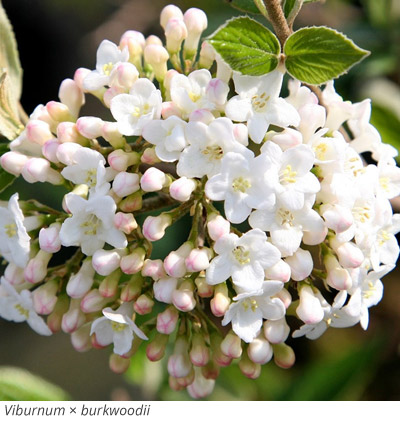 Spring is here by March and summer's on the horizon and one of the best spring scents belongs to the hyacinth. Place potfuls close to a path and tune into heaven! In the garden the best spring-flowering shrub is Viburnum x burkwoodii, an apple-white, semi-evergreen viburnum with loose domes of pink buds that open to white. The scent, reminiscent of an exotic lily, is powerful and this hybrid shrub is completely reliable and long lived. It was raised at Burkwoods Nursery in Skipworth, Kingston-on-Thames in 1924 and the parents were the rather ordinary Viburnum utile and the showy Viburnum carlesii, a shrub with suicidal tendencies. Spring is here by March and summer's on the horizon and one of the best spring scents belongs to the hyacinth. Place potfuls close to a path and tune into heaven! In the garden the best spring-flowering shrub is Viburnum x burkwoodii, an apple-white, semi-evergreen viburnum with loose domes of pink buds that open to white. The scent, reminiscent of an exotic lily, is powerful and this hybrid shrub is completely reliable and long lived. It was raised at Burkwoods Nursery in Skipworth, Kingston-on-Thames in 1924 and the parents were the rather ordinary Viburnum utile and the showy Viburnum carlesii, a shrub with suicidal tendencies.
Osmanthus x burkwoodii, another fragrant Burkwood hybrid, is a white-flowered evergreen that’s good in a dank corner. The dark green foliage could be tedious, but it’s enlivened with a crisp golden edge, so fine it could be silken thread showing through a fabric. This sparkle picks up the paler midrib and when the buds lie in waiting it’s the same sort of golden patina repeated again. White scented flowers follow, shining out against cinnamon stems, and they all point in one direction. It’s Coco Chanel in plant form, stylish and understated.
April sees a new type of fragrance, sweet and innocent and almost virginal. The Lily of the Valley or Convallaria majalis, captures sweet innocence in looks and aroma. If it loves you it will roam and spread, which is fine in its own way, but many gardeners prefer potfuls instead. The bright green leaves and well-spaced open bells in soft white demand to be admired at eye level, almost too good to be real. Give your pot a cool position in dappled shade and add a hardy fern or two and Adiantum aleuticum, the five-fingered maidenhair fern, will rise from the ground at roughly the same moment. This parasol of fine foliage trembling on black wire is an antidote to the innocence of lily of the valley.
May is the moment spring slides into summer and the moment is captured by lilac in flower, shrubs beloved by our Edwardian forefathers. Unfortunately tree lilacs (Syringa vulgaris), bred to be cut for the vase, are not strongly scented although they are entirely worthy of a space in the garden for their sense of timing. It’s the shrubbier twiggier lilacs that pack a scent and Syringa meyeri ‘Palibin, the Korean lilac, is a joy on a late spring day. A rounded bush, with rounded bright green leaves, and soft panicles of mauve flowers that fragrance a whole area of garden. Good in a pot, or the garden, and conjuring up all the mysteries of the East.
When the roses begin to bloom in June there’s another shrub, philadelphus or mock orange, that provides a sharp twist of lemon to cut through a hot June day. These are variable, with some giants and some shorties, but ‘Belle Etoile’ is one of the very finest, with white starry single flowers flushed slightly in mauve. Use it in summer borders with pink roses and summer-flowering herbaceous, or as a specimen plant in a prominent position. It never looks cool, or virginal, and the pastel flowers produce a clean, lemony scent. One to make a June evening perfect.
 Evening scent is especially important because it lures in the moths and our twining native woodbine or honeysuckle, Lonicera periclymenum, has long-tubed flowers suited to their long tongues. Not surprisingly this plant turns up the scent as the light begins to fade in July. In woods this native scrambles from shade into light, so you can tuck this away against a wall or close to a fence and it will do the same for you, scrambling into sun. Star varieties include the soft yellow, greyer leaved ‘Graham Thomas’, discovered in a Warwickshire hedgerow by the great plantsman himself. It flowers a little later than the ‘rhubarb and custard’ varieties such as ‘Serotina’. This combines pink-red tubes and pale golden petals, so it’s a dazzler in summer. Evening scent is especially important because it lures in the moths and our twining native woodbine or honeysuckle, Lonicera periclymenum, has long-tubed flowers suited to their long tongues. Not surprisingly this plant turns up the scent as the light begins to fade in July. In woods this native scrambles from shade into light, so you can tuck this away against a wall or close to a fence and it will do the same for you, scrambling into sun. Star varieties include the soft yellow, greyer leaved ‘Graham Thomas’, discovered in a Warwickshire hedgerow by the great plantsman himself. It flowers a little later than the ‘rhubarb and custard’ varieties such as ‘Serotina’. This combines pink-red tubes and pale golden petals, so it’s a dazzler in summer.
August provides a challenge for the gardener, but the garden phlox has a sweet cake fragrance that people either love or hate. One of the most scented and perpetual is the very easy stalwart Phlox paniculata ‘Bright Eyes’, with pale pink flowers eyed in shocking pink. The mauve ‘Franz Schubert’ is equally powerful when it comes to fragrance and it’s a strong grower, with pale-centred lilac pink flowers that glow in evening light. Haunting rather like Schubert’s music, written by a man destined to die young. ‘Starfire’, a deep red-pink, has superb black-tinted young foliage so this is another star performer even before it flowers. Use border phloxes in good soil, that doesn’t dry out in high summer, and they will follow summer herbaceous plants and slot into the gap when repeat-flowering roses are between flushes. They’re also excellent cut flowers and they’re stiff-stemmed so there’s no staking.
When there’s an ‘r’ in the month, summer is sadly over but you can celebrate September by planting herbaceous clematis and these blue non-climbing clematis are all highly fragrant. Clematis heracleifolia ‘Cassandra’ is one of the best and it’s recurved clusters of bright blue flowers are a butterfly magnet as well.
 Gardens thrive in October because winter comes later than it used to and there are several roses known for their late burst of fragrance. ‘Bonica’ will bear large clusters of pretty pink cup shaped flowers until winter intervenes and it’s one of those healthy good-doers that’s hardly ever out of flower. It’s even good on poor soil. ‘You’re Beautiful’ also has a late flush and this recipient of the Rose of the Year in 2013 is a very healthy rose with substantial strong pink flowers. Gardens thrive in October because winter comes later than it used to and there are several roses known for their late burst of fragrance. ‘Bonica’ will bear large clusters of pretty pink cup shaped flowers until winter intervenes and it’s one of those healthy good-doers that’s hardly ever out of flower. It’s even good on poor soil. ‘You’re Beautiful’ also has a late flush and this recipient of the Rose of the Year in 2013 is a very healthy rose with substantial strong pink flowers.
November cheer should be an essential part of any garden and there are two superb, top notch scented shrubs to gladden the gardener’s heart. They can both be placed on the outer reaches and still fragrance the garden. The hyacinth-scented Viburnum x bodnantense ‘Dawn’ is at its best for fragrance this month and the scent is very similar to hyacinth. It will continue to flower in flushes during clement spells and is an excellent boundary plant, but fragrance peaks in November. If there’s a slightly shaded or west-facing position opt for the very architectural Mahonia x media ‘Charity’ and its upright and spreading racemes of clear yellow flowers supported by slightly prickly, ash-like rich green leaves. This shines in this, the drabbest month of all. ‘Winter Sun’ produces longer narrower racemes and is equally well thought of.
Plant these and you’ll have a year of fragrance every year. |



